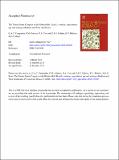The Tonian Embu Complex in the Ribeira Belt (Brazil) : revision, depositional age and setting in Rodinia and West Gondwana
Abstract
The Embu Complex in the Neoproterozoic Ribeira Belt of Brazil provides a record of sedimentation associated with the Rodinia supercontinent and its subsequent deformation and metamorphism during assembly of West Gondwana. It is composed of a succession of variably migmatized pelitic schists and paragneisses, as well as minor calcsilicate rocks with quartzite intercalations, and orthogneiss. Detrital zircon U-Pb (LA-ICP-MS and SHRIMP) determinations for key samples of the Embu Complex in its type-area (West and Southwest of São Paulo City), and samples from neighboring units (Votuverava and São Roque groups) indicate distinct provenance histories and in combination with other data, discrete times of sediment accumulation. Detrital zircons from the Embu Complex are characterized by ages in the range 1500-1000 Ma and 2000-1700 Ma, with a very minor number of older ages. The youngest detrital grain is dated at 974 ± 12 Ma. Metamorphic zircon overgrowths range from 850 to 570 Ma with age peaks at ca. 820-790 and 650-570 Ma. Thus, the depositional age of the Embu Complex is constrained to 970-850 Ma. The detrital zircons of the Votuverava and São Roque groups are dominated by ages in the range 2200-2000 Ma, along with minor Paleoproterozoic and Archean ages. The youngest detrital grains are ∼1400 Ma (Votuverava Group) and ∼1750 Ma (São Roque Group). Metamafic rocks from the Votuverava Group have crystallization ages of ca. 1300 Ma, with a higher metamorphic grade amphibolite showing a range of discordant ages with upper and lower intercepts of 1300 Ma and ∼800 Ma, respectively. These results demonstrate that the Embu Complex was probably accreted to the Apiaí Terrane during a Tonian (820-790 Ma) orogenic event, prior to final development of the Ediacaran Ribeira belt arc-related magmatism and a transcurrent shear zone system. The main source area for detrital zircons of the Embu Complex is likely to be the Grenville-Sveconorwegian-Sunsás orogen or time-equivalent regions rather than the central portions of the neighboring cratons. The Embu Complex geological context is consistent with accumulation on the margin of the Rodinia supercontinent.
Citation
Campanha , G A C , Faleiros , F M , Cawood , P A , Cabrita , D I G , Ribeiro , B V & Basei , M A S 2018 , ' The Tonian Embu Complex in the Ribeira Belt (Brazil) : revision, depositional age and setting in Rodinia and West Gondwana ' , Precambrian Research , vol. In press . https://doi.org/10.1016/j.precamres.2018.10.010
Publication
Precambrian Research
Status
Peer reviewed
ISSN
0301-9268Type
Journal article
Description
Funding: Conselho Nacional de Desenvolvimento Científico e Tecnológico – CNPq, grants 443439/2014-1 and 305074/2015-6, the Fundação de Amparo à Pesquisa do Estado de São Paulo – FAPESP, grant 2015/04487-7, and the Australian Research Council, grant FL160100168.Collections
Items in the St Andrews Research Repository are protected by copyright, with all rights reserved, unless otherwise indicated.

